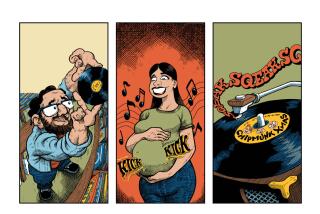Tape Cassettes Are Going the Way of the Eight-Track
- Share via
It’s nearly the final rewind for the tape cassette.
Once the format of choice for recorded (and recording) music, the mighty cassette has finally met its match in a digital sonic universe filled with alternatives. The cassette is being crowded out of the music market, figuratively and literally.
The attack is coming from all sides. The recordable compact disc, once the purview of professionals, has evolved into an affordable, plug-and-play technology. Tiny digital gadgets stuffed with mini-memory cards download pure CD-quality music off the Internet. Sony continues to market its MiniDisc as the natural replacement for the cassette, and even newer technologies wait just over the next high-tech ridge.
In figures recently released by the Recording Industry Assn. of America, cassette unit shipments last year in the United States dropped 22%, from 158 million in 1998 to 123 million. In dollars, the format’s sales decreased from $1.4 billion in 1998 to $1.1 billion in 1999.
The origins of the cassette reach back almost 40 years, to 1963, when engineers from Philips in Europe paired their plastic shell--formally dubbed the compact cassette--with a new, ultra-thin, low-noise tape from a company called BASF.
Originally designed for recording voices, the cassette, which coexisted for a time with the eight-track tape before that inferior system became extinct, was quickly adapted for music, and frequently tweaked and improved through the years, mainly thanks to an audio engineer named Ray Dolby, whose now-standard noise-reduction system eliminates annoying tape hiss.
Philips still includes cassette players--but only in the lower end of its range of audio products. The emphasis now is on the recordable compact disc technology. “A whole generation grew up with cassettes, but now a new generation is being brought up on compact disc,” said Andy Mintz, a Philips vice president for its audio division.
And there seems to be little romance attached to the cassette in a bottom-line business like consumer electronics. During a recent line showing that focused on Philips’ new CD recorders--including recorders replacing cassette players even in mini-audio systems--company executive Des Power noted how “cassettes are in for a rough time” and said afterward that it’s “logical” to expect the cassette to go away eventually.
At their peak in the late ‘80s, tape cassettes accounted for the bulk of recorded music sales, as vinyl nearly evaporated in the face of competition from a new format called the compact disc (which, ironically, Philips co-invented with Sony).
But it didn’t take the CD format long to establish authority in the mass market: It offered no cracks, no pops, no hiss and infinite wear because nothing touches the disc but a laser beam. Only a half-dozen years after it came out in the mid-’80s, the CD claimed the majority share of the U.S. music market, eclipsing the cassette in 1992. (CDs now account for a whopping $12.8 billion in yearly sales, or about 87% of the total prerecorded music market.)
But the cassette remained a contender. Though inferior in sound, it was far more portable (and less expensive) than CDs. The Sony Walkman and its imitators were proliferating, cheaper and more sturdy than portable disc players. The cassette was recordable and the CD wasn’t. It was perfect for the automobile. For all its shortcomings, tape was funky. And in an electronics industry becoming more complex and less user-friendly, it was a no-brainer.
Cassettes Have Faced Many Challengers
In the past decade or so, other gadgets have come to kick at the cassette. Most have gone away.
When it became clear that “digital” was the adjective of choice, Japanese manufacturers came up with DAT, for digital audio tape: It offered a vast improvement in tape fidelity, at a vast cost increase. And it was not compatible with existing cassettes. DAT survives, mainly as a format for professionals.
The DCC from Philips--for digital compact cassette--appeared in the late ‘80s, coinciding with the arrival of Sony’s clever MiniDisc system, and each was heralded as the cassette’s successor. DCCs looked a lot like regular cassettes, and DCC machines were “backwards compatible”--they could play them. Almost no one cared, and DCC died an unheroic death.
In the MiniDisc camp, blank discs and players were initially more expensive than blank tapes and portable cassette players, and there were very few prerecorded MDs available in the Western world. Today, prerecorded MDs are virtually nonexistent in the United States.
But Sony is nothing if not persistent, and persistence is paying off. MD is now one of the recordable formats of choice in Japan, its popularity is spreading in Europe, and there are periodic spurts of advertising aimed at U.S. consumers.
Still, there are those who continue to champion the ailing cassette format.
Last year, a trade group called the International Media Recording Assn., based in Princeton, N.J., tried to shore up the cassette format with a public awareness campaign orchestrated by a spinoff group called the Audio Cassette Coalition. Lou Vaccarelli, a vice president with BMG Entertainment, co-chaired the committee.
“We tried to help save the cassette, and I think we did stem the decline,” he said. “But now, without our campaign and with the way music is going. . . .” The conclusion was unsaid, but implicit.
Vaccarelli, who sees memory chips like Sony’s Memory Stick as the future of music recording, expects that cassettes will live on as recorded books and for other spoken-word uses, and may still have a life “like the vinyl LP. There will always be a limited market.”


